Suunto ZoneSense
-
@stromdiddily graph please
-
@mlakis said in Suunto ZoneSense:
@Brad_Olwin, well since I don’t understand, upload a screenshot from an endurance activity of yours with ZS and HR plotted and explain to me how you used ZS, because from mine and of other’s activities that are posted here, even from those from Suunto’s initial release, it seems that ZS numbers are totally counterintuitive, because ZS drops when effort ramps up and goes up when effort ramps down.
This is my entire point! Hopefully I can explain better. I am not examing my HR and ZS plots after my run, I have CTL TSS and TSB for that. During my run I use the ZS app and monitor whether I am aerobic or not. On an endurance run I will keep ZS in the high green and low yellow. For recovery runs green only. For tempo intervals mid to high yellow. in the app I relate my RPE with what ZS suggests for my AT, which is at my-expected threshold if I am well recovered and feel good or lower if I am fatigued. I use ZS in real time to manage my effort and use this for races as well.
Examing the graphs after the fact is not what ZS is useful for. If I am doing shorter and harder intervals I will use power, not ZS. -
@stromdiddily exactly my usage as well. Congratulations on your race!
-
Hat I could tell is the folllowing
Most of the time Zs works fine, I saw however few runs at high intensity (Wednesday is my vo2max day) where Zs stay in green
When I look to the rr data in runalyse after I see looots of artifact (more than 15%)
I think it is working well when data collection is good.
@Brad_Olwin may I ask you which belt you are using ?
For those that complain did you look over your rr artifacts ? Maybe it could explain a bad behavior -
@Josaiplu how long are your Vo2max efforts? Well known that short intervals are not going to be represented by ZS, this is a known limitation.
400s on the track at Vo2max are a no go.
800s are better represented specially after 2nd interval but real intensity is represented on the last part only.For short interval should keep using pace or time not even HR

400s
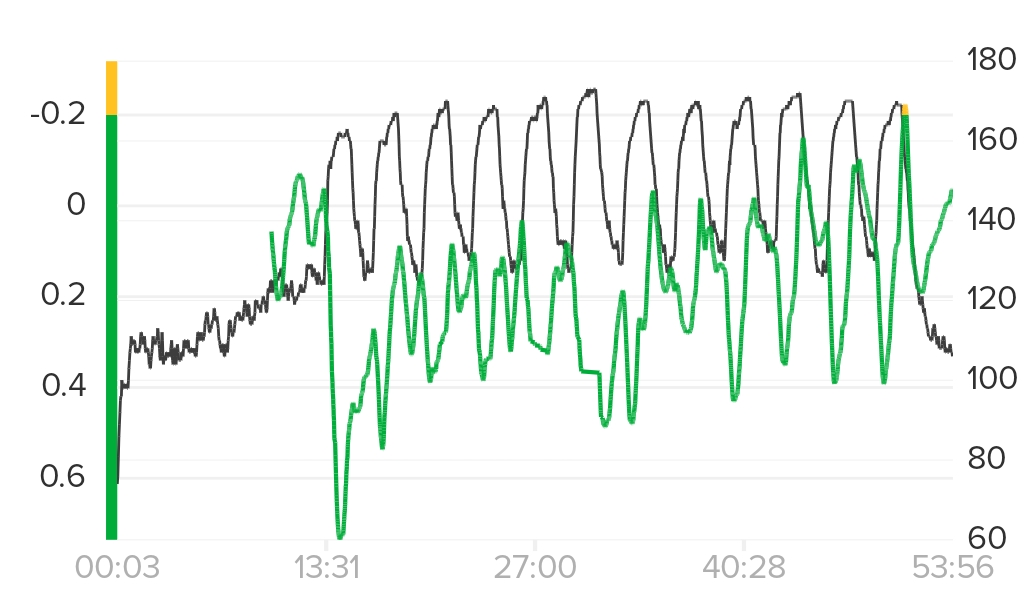
800s
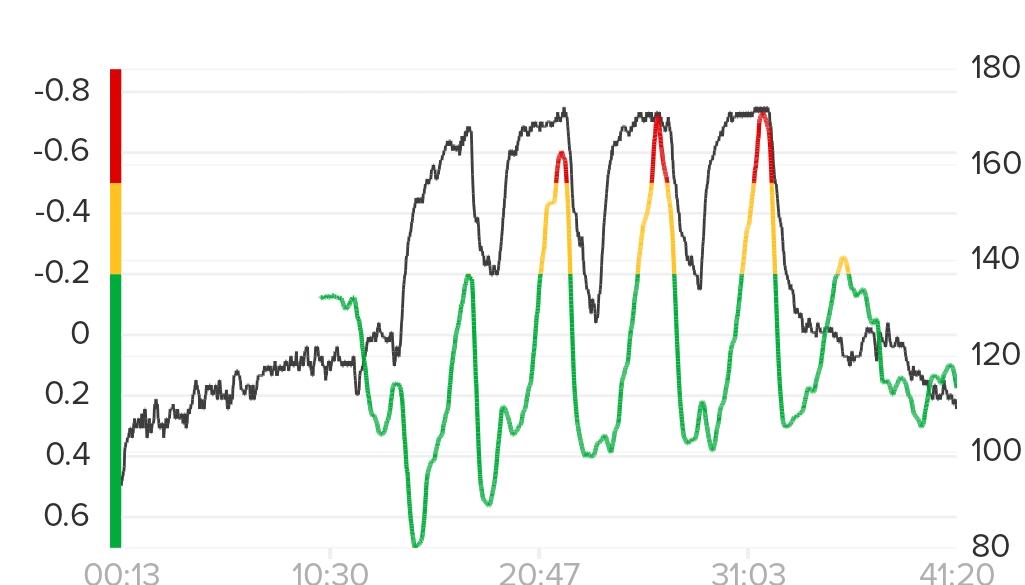
-
@herlas I know that I did not do 30-30 interval I go run for 1 v max out like it is a race, sometime I walk if I m out of breath or ascent is too high but it s a long max out race, I know it s not fully a vo2 max but sa put this tag on it and zs remain green on one of them
Example with low artifacts
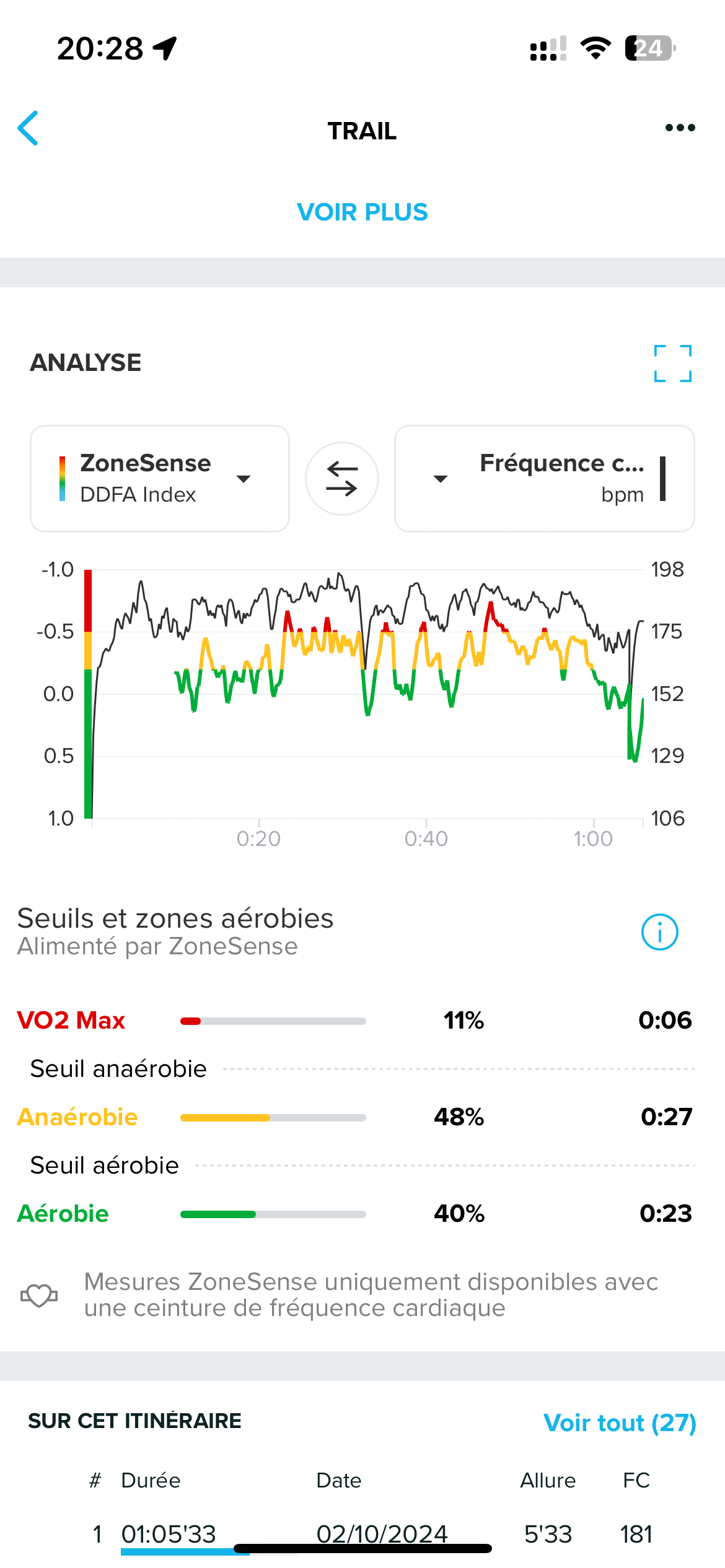
Example with either artifact or bad fc detection
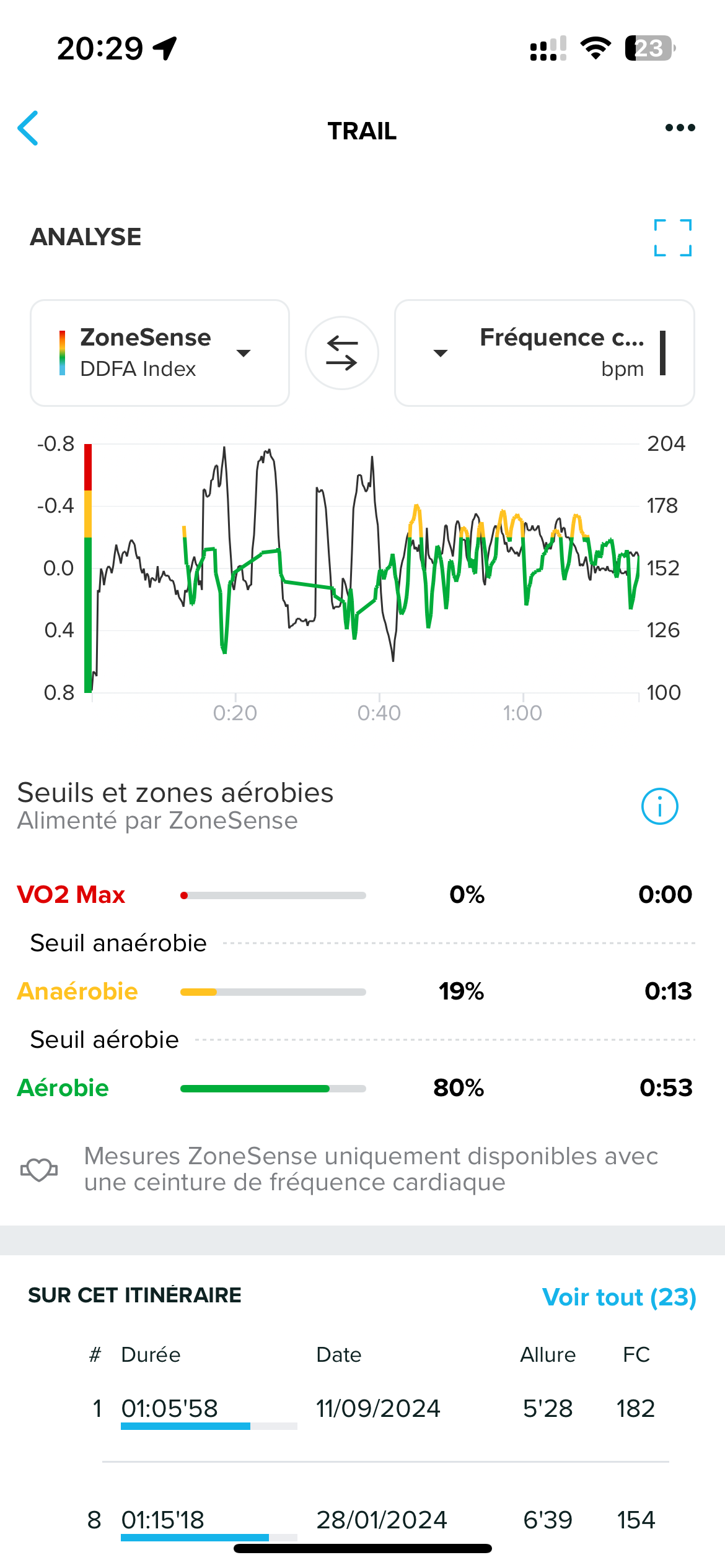
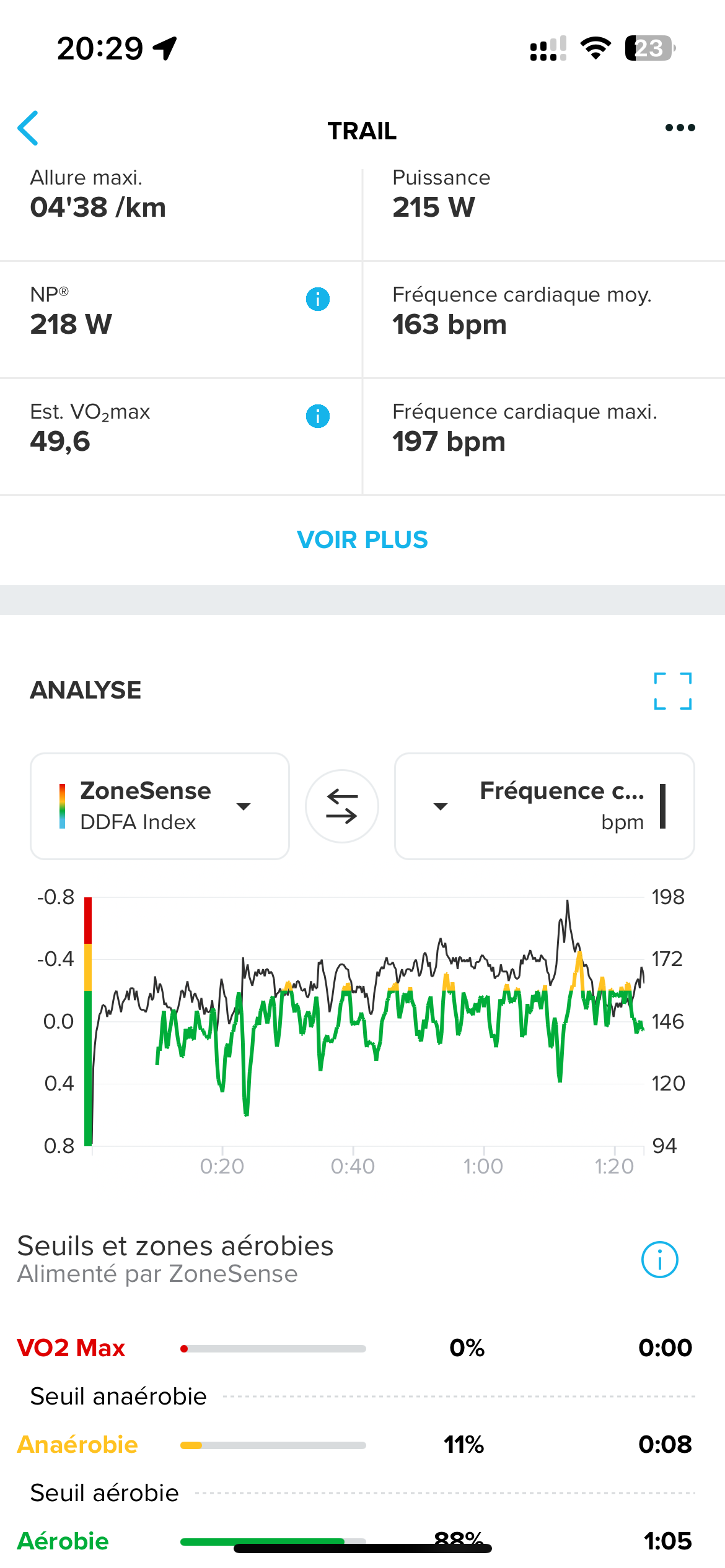
Last picture there is an increase in fc and zs go down for exemple
On my bike however I never get a bad detection so I think artifact could have an impact
In the past I watch a video that explain how to detect threshold using dfa1 and it is hard to do with running while on a bike it is easier because there is less artifacts -
@Brad_Olwin, no graphs yet.
I want a graph of ZS/HR and an explanation of how ZS helped you better than HR to pace your effort, in respect also to how many times the ZS was showing nonsense and instead of helping you it was misleading you.
That’s what we are examining, what metric helps you better to pace you efforts.
So, graph please.
-
@Josaiplu your activities shown are not apple to apples right, in one you’re doing high intensity short periods vs the other it’s more sustained. Either way, I agree, if belt has issues it’ll throw off ZoneSense and if it’s that bad, even HR graph. you might need to replace your belt or sensor if this is happening frecuently, depending what your specific situation is and when completely sure that’s needed
 .
.ZS dropping to green after a quick change in effort, like increasing pace for an interval start is known and it’s expected AFAIK.
-
@mlakis said in Suunto ZoneSense:
@stromdiddily graph please
I don’t understand your graphs requirement to validate pacing guidance DURING the effort. Post workout, my ZS aerobic hr was 135. That’s ten beats lower than my entered zone 2 primarily because it was hot as heck and I was at elevation.
If I would have followed the heart rate zone, more than likely I’m blowing up because I’m working way harder on that specific day than I was when I set my zones originally.
It was a 26.5 hour activity. My graph isn’t going to help you.
-
@herlas yes and I did not post to complain I like the feature a lot and use it most of the time my point was just for people that complain maybe looking into their data could explain strange behiavior

-
@stromdiddily, since we are talking about data/metrics, graph IS the data/metric, which should be the same during and after the workout.
If during a workout that is 1/2/5/24/72 hours ZS is showing nonsense in a large percentage of the duration in respect to when you could draw a useful conclusion, then it’s not useful.
HR, Power and their zones are metrics that give you insight about your effort further than your perception, even before you exert yourself. They go beyond perception.
A metric that shows me something meaningful 5% of the time that also agrees with my perception like when I can’t hit my usual numbers when it’s hot, if I am a bit ill, when I have overcooked myself the previous days or on the first hours of my activity etc, does not give me something useful, and also is misleading for the rest 95%.
So, I insist for graphs and an explanation on how HR or Power that are drawn/shown can’t help you in a better way than ZS can.
-
@Brad_Olwin I actually rarely looking on my HR Zones too now . I run with Zonesense and rely on it. IMO it’s great. I used to look on my HR zones and this was a constant distraction. With Zonesense I just run and when I feel, that I might have changed to another zone I check the display and see if that’s the case (and it often corresponds) and then I adjust my tempo correspondingly. For me I consider it kind of a game changer.
-
ZoneSense app has been updated on 10th October.
-
@dulko79 Anyone know if it will automatically update on the next watch SuuntoPlus sync? Or do you need to remove and re-add it?
-
@mlakis said in Suunto ZoneSense:
@Brad_Olwin, no graphs yet.
I want a graph of ZS/HR and an explanation of how ZS helped you better than HR to pace your effort, in respect also to how many times the ZS was showing nonsense and instead of helping you it was misleading you.
That’s what we are examining, what metric helps you better to pace you efforts.
So, graph please.
So, graphs are NOT helping me pace, looking at HR won’t matter because I do not gauge effort by HR. I keep trying to make this point ! I am solely basing effort on RPE when not using Zone Sense and now I am using ZS for pacing. My HR is irrelevant. I have now explained several times how ZS is helping me pace and I do not use HR so an HR graph will not help you to understand how I use ZS for managing my effort.
-
@ChrisA exactly the point I am trying to make! Thanks!
-
@stromdiddily said in Suunto ZoneSense:
@mlakis said in Suunto ZoneSense:
@stromdiddily graph please
I don’t understand your graphs requirement to validate pacing guidance DURING the effort. Post workout, my ZS aerobic hr was 135. That’s ten beats lower than my entered zone 2 primarily because it was hot as heck and I was at elevation.
If I would have followed the heart rate zone, more than likely I’m blowing up because I’m working way harder on that specific day than I was when I set my zones originally.
It was a 26.5 hour activity. My graph isn’t going to help you.
Thanks! This is exactly my point. Others here are trying to force a relationship where one does not exist. There are a lot of data demonstrating why HR, Pace and Power are poor determinants to use while assessing trail running effort especially during ultras!
-
@mlakis These perceptions are incorrect! For trail running and ultras pace, power and HR are either poor measures of effort or absolutely unhelpful. For example, after 6h, 15h or 20h of an ultra HR is useless as you are dramatically increasing fatigue! Power is useless as sand,. Roots and rocks are not assessed by power, neither is the cost of eccentric contractions running downhill. Similarly, pace is useless as well. That is why most trail and ultra runners use RPE. Now we have ZS and I think a game changer as I can prevent myself from going too fast at the beginning and too hard uphill.
-
@Josaiplu I am using a Suunto smart sensor belt. it is comfortable as the sensor is small.
-
@Brad_Olwin, I am talking about cycling power using a power meter which is spot on, not running power which is a poor derived estimated metric by the watches.
So, we have arrived to the conclusion that ZS is useful for trail running efforts equal on over 6 hours.
That’s a progression to initial statements of where ZS is useful/meaningful.
Thanks.